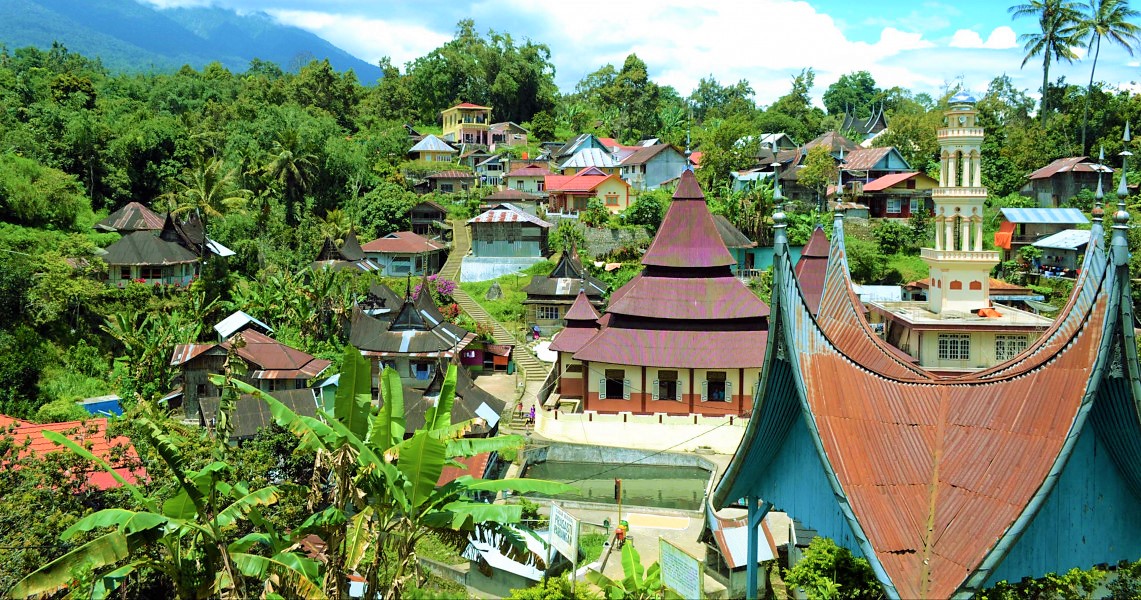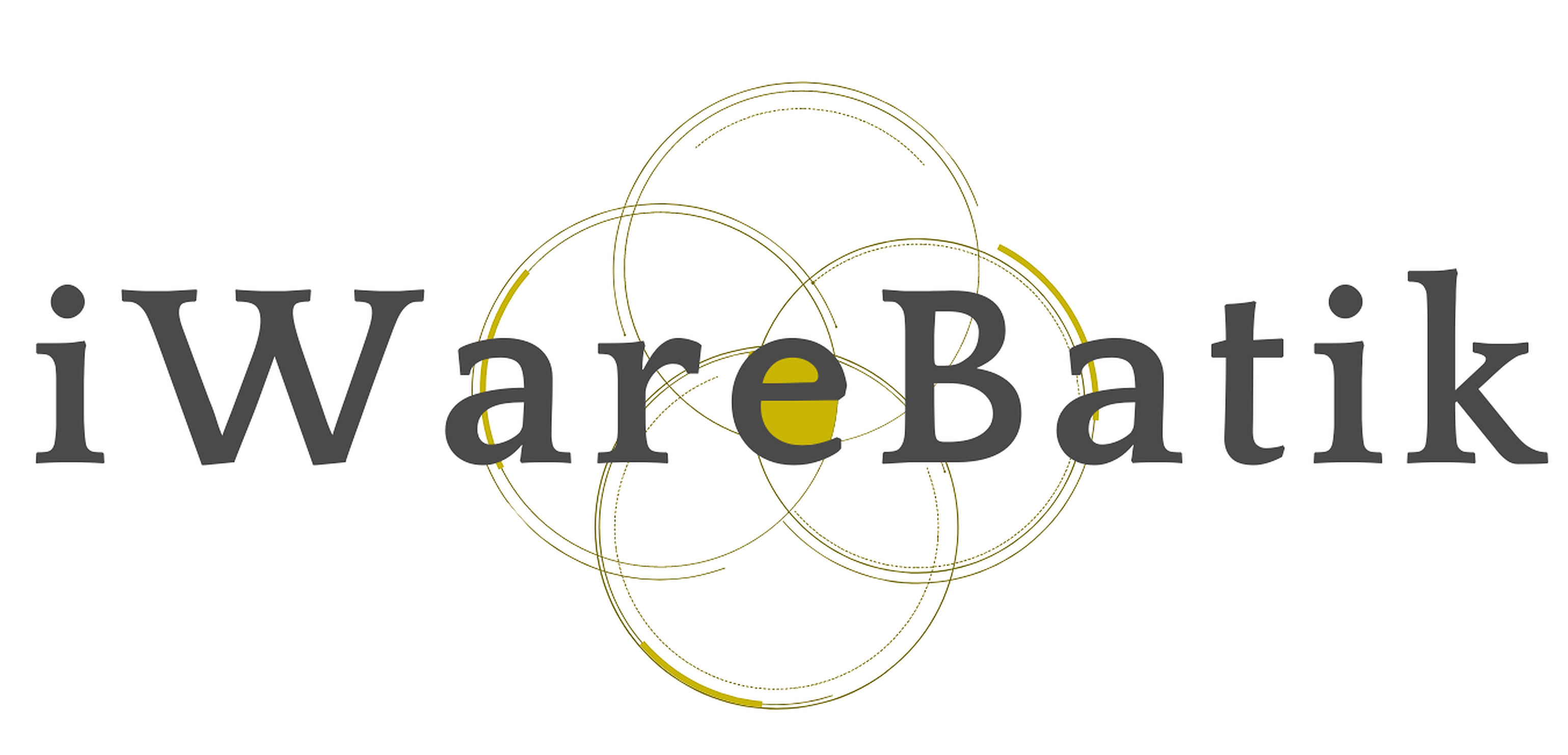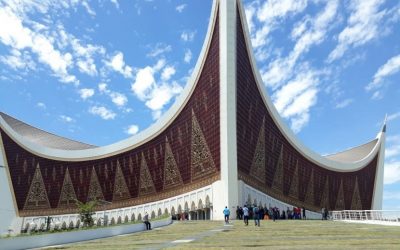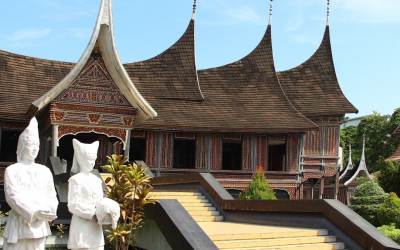Home / Batik Regions – Western Indonesia – Northern Sumatra – West Sumatra / Pariangan Cultural Village
Cultural Destination
Embrace the spirit of the place!
Pariangan Cultural Village

The Pariangan Cultural Village (photo: Pesona Indonesia)
Pariangan Cultural Village
Nagari Pariangan has been declared as the most beautiful village in the world, according to Travel Budget, a tourism media based in New York, USA. This village has a beautiful natural and cultural landscape of an ancient Minangkabau village. This village was blessed with traditional community-based management which is able to preserve the common characteristics and cultural identity of West Sumatra. This place is also well-known as one of the most-favourite destinations during the annual international bicycle racing event, Tour de Singkarak. Nagari Pariangan can be reached in about three hours from Padang, the capital city of West Sumatra Province.
Tourist Attractions in West Sumatra
West Sumatra Grand Mosque
The Great Mosque of West Sumatra is characterized with its Minang-styled air ventilations to
Museum of Adityawarman
The museum was built to commemorate Adityawarman, a king of Minangkabau in
West Sumatra
Batik Motifs
Rangkiang
The word “Rangkiang” refers to the rice granary in the Minangkabau language. It symbolizes
Tanah Liek
The word “Tanah Liek” refers to clay in Minang language. It is also known as
Keluak Daun Pakis
The word “Keluak” is a Minang language which means twisted or tangled. The Motif of
Discover
Indonesian
Batik
Motifs
Rumah Mamuju
the Batik motif illustrates the house of Mamuju King with the stairs, located on the left of the wooden stage house
Leuit Sijimat
This motif reflects the daily activities of the Baduy tribe in Banten. The main ornaments of batik motif consist of:
Enggang Dayak
Local people beliefs that hornbills are an incarnation of the Commander of the Birds. It has supernatural
Pucuk Rebung Riau
Pucuk Rebung symbolizes heart determination in achieving goals, good luck, and
Sido Mulyo
Sidomulyo is one of the classical motifs, which is specifically used for the bride’s costume in
Pala Salawaku
This motif illustrates the unique weapons of the Maluku region, namely
Besurek Rafflesia
The term “Basurek” refers to a textile that contains letters or inscriptions
Sandeq
Sandeq Boat is a symbol of the maritime importance of the West Sulawesi region. The greatness of
La Galigo
La Galigo is a literary work of the Buginese Epic that has 300 thousand epic lines. It is considered even
Pattimura
Pattimura is the name of an Indonesian hero who fought against colonialism in
Merak Ngeram
The hatching peacock motif has a very deep meaning which refers to the sacrifice and
Dayak Taghol
Dayak Taghol has a distinctive style of four curved lines and small dots. This motif represents
Bultiya
The word ‘Bultiya’ is an acronym of the three major tribes in North Kalimantan, namely
Daun Lada Hitam
The black pepper motif represents the main commodity of Bangka Belitung
Malinau Cultural Festival
You will witness a unique competition that might not be found other than in
Parang Rusak
Another meaning behind this motif is an unconquerable spirit, symbolized by
Gamolan
This motif illustrates Gamolan, a bamboo musical instrument of Lampung that is
Lipaq Sabe
Lipaq Saqbe contains a simple geometric classical motif with various flower decorations. This textile is
Tikar Natuna
The Tikar Natuna motif is adapted from the traditional making of pandanus mats in
Karawo Mahkuta
Mahkuta refers to Gorontalo’s traditional crown. It represents noble characters of
Salakanagara
Salakanagara batik motif illustrates the first kingdom in the Betawi land
Parang Seling
Parang Seling or “alternating daggers” is a royal batik motif. It is a feminine variant of
Jumputan Bintang
The word Jumputan means the tie-dye technique, while the word “Bintang” refers to
Kaharingan
The Kaharingan or ‘tree of life’ based on the Dayak tribes’ belief system. This tree symbolizes
Ikan tambal
The word “Ikan” refers to fish. The philosophical meaning of Ikan Tambal means is
Kain Cual
Cual textile tradition has existed since the 17th century. The word “Cual” refers to
Tampuk Manggis Sasirangan
The motif illustrates the philosophy of the mangosteen fruit, which is
Manguni Minahasa
Manguni is identified as the symbol of the Minahasa people. Manguni is known as a
Cengkeh
The clove flower motif is the main commodity of the Tolitoli Regency. This motif represents
Bekantan Pakis
This motif represents Pakis Haji (Polystichum setiferum), an endemic plant in
Honai
The Honai is inspired by the traditional house of the Papuan community living in
Kerawang Tegak Aceh
The Vertical Upright (Kerawang Tegak) Motif symbolizes a person who has a strong
Gajah Way Kambas
The motif illustrates the Lampung’s natural reserve, the Way Kambas. it also symbolizes
Keluak Daun Pakis
The word “Keluak” is a Minang language which means twisted or tangled. The Motif of
Gorga Simeol-Meol
The Gorga Simeol-meol is a pattern of plant tendrils. it is regarded as a symbol of longevity and
Gonggong Beruntun
This motif illustrates that a person should maintain a positive attitude and
Biji Kopi
The coffee seeds motif illustrates the pride of local coffee specialities in
Daun Sirih
This motif illustrates betel leaves that are used by Lombok communities as traditional
Kasih Tak Sampai
‘Kasih Tak Sampai’ is an idiom in the Indonesian language which refers to
Buketan Bali
The Balinese bouquet (Buketan Bali) is a floral arrangement and the name is
Kuda Kupang
Horses symbolize wealth. It contains noble values of virtuous characters that bring
Tanah Liek
The word “Tanah Liek” refers to clay in Minang language. It is also known as
Desa Na Tolu
The Desa Na Tolu characteristic pattern symbolizes the Batak philosophy of existence and
Angsa Duo
According to legend, the Angso duo batik motif is a pair of swans that are believed to have led Princess
Prada Papua
The word “Prada” in the Javanese-Indonesian dialect means a batik textile that
Pohon Hayat (Tree of Life)
The Batik motifs in Lampung are dominated by the acculturation of Buddhist and
Sekar Jati
Sekar means flower and Jati refers to teak trees that symbolizes a strong mental character that
Wakatobi
It symbolizes the coastal beauty of the Wakatobi island and the symbol of Patra symbolizes
Ukir Sentani
The Ukir motif is a batik motif that is inspired by various traditional Sentani wood carvings
Karawo Pinang
Pinang refers to the Palm areca tree. This motif is considered as the original
Jupri Kembang Teh
Kembang Teh illustrates the tendrils of tea plants that grow in the highlands of
Sero Tangga
The Sero Tangga illustrates an endearing feeling and sacrifices of a person to fulfil
Bomba Mawar
This motif means sacred love for family, kingdom, and God; It also illustrates
Daun Simpor
This motif is inspired by the Simpor plant (Dillenia Suffruticosa) which is a typical
Tenun Bima
The motifs are adopted from Bima woven textile. This pattern has received a great
Tifa Totobuang
The batik motifs illustrate Maluku’s traditional music instrument called
Pinawetengan
The Pinawetengan Batik pattern was taken from a prehistoric inscription in
Tongkonan
Toraja’s traditional house is called Tongkonan. Tongkonan is a place for
Pati-Pati Pinehiku
It symbolizes the hierarchy in society and the social status of the Mekongga
Kawung
The Kawung motif was created by Sultan Agung Hanyokrokusumo (1593 – 1645) as a symbolic gift for
Lok Baintan Floating Market
As you can imagine, the most authentic thing is that you can buy things and even
Rangkiang
The word “Rangkiang” refers to the rice granary in the Minangkabau language. It symbolizes
Besurek Rembulan
This batik illustrates praise for God who created the wonderful universe
Ake Patra
Ake is related to the divinity and the composition of the universe. It is a symbol of
Tabir Tanjung
Tanjung flower is a type of Cherry tree flower, which is commonly found in
Wirasat
Wirasat or divine inspiration is a gift from God. This inspiration is symbolized by
Gedhog Kembang Waluh
a combination of Javanese cultural motif of the Majapahit kingdom (XII-XIV century) with
Srimanganti
The name of the Srimanganti motif is derived from Palace’s hallway that connects to
Raja Ampat
Raja Ampat motif represents the marine life at Raja Ampat archipelago in
Gurdo Solo
Gurdo or garuda bird is the mount of the Indian god Vishnu. As the Sun Bird,
Kaganga Tanah Rejang
If Batik Besurek combines Arabic calligraphy motifs, then the Kaganga batik takes




